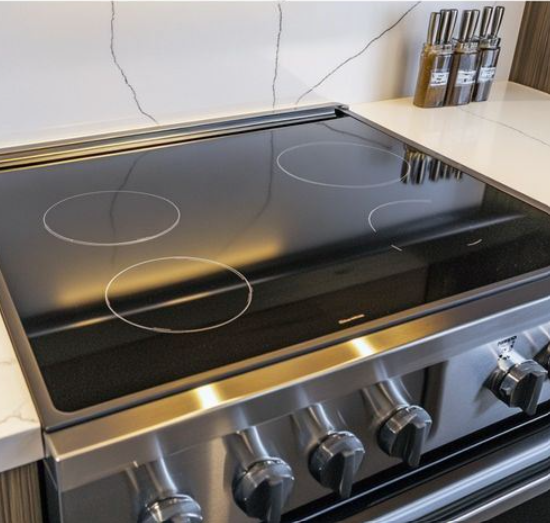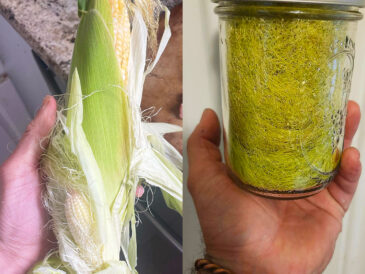Follow these steps to quickly restore your glass stovetop to its shiny best:
Step 1: Allow the Stovetop to Cool Completely
Never start cleaning when the surface is hot to avoid burns and thermal shock damage.
Step 2: Remove Loose Debris
Use a dry microfiber cloth to wipe away crumbs and loose particles.
Step 3: Scrape Off Burnt Food Residue
Gently use a ceramic stove scraper at a 45-degree angle to carefully lift hardened food particles without scratching.
Step 4: Prepare a Cleaning Solution
Mix in a spray bottle:
- 1 part white vinegar
- 1 part warm water
Optionally, add a few drops of liquid soap for extra degreasing power.
Step 5: Apply the Solution
Spray the mixture generously across the stovetop, focusing on greasy or stained areas.
Step 6: Let it Sit for 5-10 Minutes
This waiting period allows the vinegar to break down grease and grime.
Step 7: Sprinkle Baking Soda
Lightly dust baking soda over the surface, especially on stubborn spots.
Step 8: Gently Scrub with a Soft Sponge
Using a damp non-abrasive sponge, gently scrub in circular motions. Baking soda’s mild abrasiveness helps lift stains without damage.
Step 9: Wipe Clean with a Microfiber Cloth
Use a clean, damp microfiber cloth to remove all residues and cleaner.
Step 10: Dry and Buff to Shine
Finish by drying with a fresh microfiber cloth to prevent streaks and restore shine.
6. How to Remove Burnt-On and Stubborn Stains Without Scratching
Burnt stains can be tricky but manageable:
- Apply baking soda directly on the stain.
- Spray with vinegar and let it fizz and bubble for 10-15 minutes.
- Use the ceramic scraper to carefully loosen the residue.
- Follow up with gentle scrubbing using the sponge and then rinse well.
- Repeat if necessary, but avoid excessive force to prevent damage.
7. Routine Maintenance Tips to Keep Your Cooktop Shiny
- Wipe down the stovetop with a damp microfiber cloth after every use once cooled.
- Avoid letting spills dry and harden.
- Monthly deep clean using the vinegar and baking soda method keeps buildup away.
- Use stovetop protectors or covers if possible.
- Avoid dragging pots and pans to prevent scratches.
8. Best Practices to Extend the Life of Your Glass Cooktop
- Use cookware with flat, smooth bottoms to avoid scratching.
- Avoid sliding pots or utensils across the glass surface.
- Never pour cold water on a hot stovetop.
- Regularly inspect for cracks or chips and address issues promptly.
- Use only manufacturer-recommended cleaners when in doubt.
9. Eco-Friendly and Cost-Effective Cleaning Solutions
Switching to natural cleaners like vinegar and baking soda reduces environmental impact and cuts down on household chemical exposure. These inexpensive, non-toxic alternatives are safe for your family and pets while delivering impressive cleaning power.
10. Final Thoughts: Achieving a Spotless Cooktop in Minutes
Cleaning your glass stovetop does not have to be a dreaded chore. By following the right steps and using the appropriate tools and natural products, you can achieve a gleaming, scratch-free surface quickly. Preventing buildup with regular maintenance ensures that cleaning remains effortless.
11. FAQ: Your Most Common Glass Cooktop Cleaning Questions Answered
Q: Can I use commercial glass cleaners on my stovetop?
A: It’s best to avoid typical glass cleaners as they may contain harsh chemicals that damage the cooktop. Stick with products formulated specifically for glass stovetops or natural solutions.
Q: How often should I deep clean my glass cooktop?
A: Ideally, perform a thorough cleaning once a week, with daily light wipes after cooking.
Q: What should I do if my stovetop gets scratched?
A: Minor scratches may be minimized with special polishing creams, but deep scratches might require professional repair or replacement.
Q: Can I use a razor blade scraper on all glass stovetops?
A: Use only scrapers designed for ceramic glass surfaces and apply them at the correct angle to avoid damage.
Bonus Tips for Faster Cleaning
- For quick spot cleaning, dampen a cloth with vinegar and wipe immediately after spills cool.
- To keep the glass shining, buff with a microfiber cloth dipped lightly in lemon juice.
- Use silicone or wooden utensils to avoid scratching during cooking.
Conclusion
Mastering the art of cleaning your glass stovetop quickly and effectively is all about knowing what to avoid and how to apply gentle but efficient methods. Using natural products like vinegar and baking soda, combined with the right tools and consistent maintenance, guarantees your stovetop will look like new for years.
Take control of your kitchen cleaning routine today — your sparkling glass cooktop awaits!




